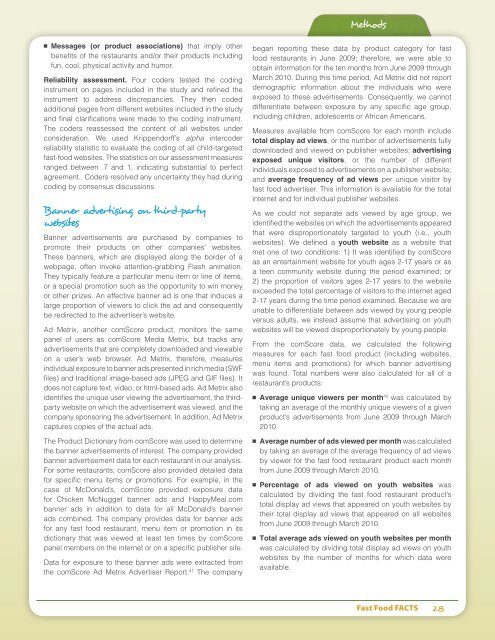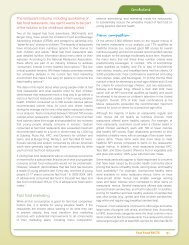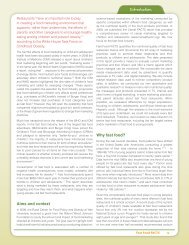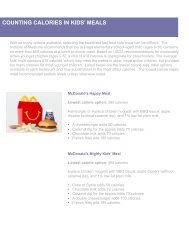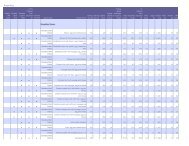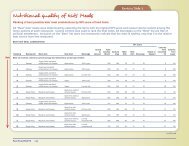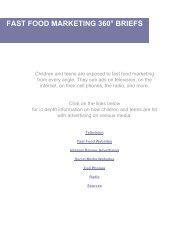Methods Fast food menus and nutritional quality - Fast Food FACTS
Methods Fast food menus and nutritional quality - Fast Food FACTS
Methods Fast food menus and nutritional quality - Fast Food FACTS
You also want an ePaper? Increase the reach of your titles
YUMPU automatically turns print PDFs into web optimized ePapers that Google loves.
■ Messages (or product associations) that imply other<br />
benefits of the restaurants <strong>and</strong>/or their products including<br />
fun, cool, physical activity <strong>and</strong> humor.<br />
Reliability assessment. Four coders tested the coding<br />
instrument on pages included in the study <strong>and</strong> refined the<br />
instrument to address discrepancies. They then coded<br />
additional pages from different websites included in the study<br />
<strong>and</strong> final clarifications were made to the coding instrument.<br />
The coders reassessed the content of all websites under<br />
consideration. We used Krippendorff’s alpha intercoder<br />
reliability statistic to evaluate the coding of all child-targeted<br />
fast-<strong>food</strong> websites. The statistics on our assessment measures<br />
ranged between .7 <strong>and</strong> 1, indicating substantial to perfect<br />
agreement.. Coders resolved any uncertainty they had during<br />
coding by consensus discussions.<br />
Banner advertising on third-party<br />
websites<br />
Banner advertisements are purchased by companies to<br />
promote their products on other companies’ websites.<br />
These banners, which are displayed along the border of a<br />
webpage, often invoke attention-grabbing Flash animation.<br />
They typically feature a particular menu item or line of items,<br />
or a special promotion such as the opportunity to win money<br />
or other prizes. An effective banner ad is one that induces a<br />
large proportion of viewers to click the ad <strong>and</strong> consequently<br />
be redirected to the advertiser’s website.<br />
Ad Metrix, another comScore product, monitors the same<br />
panel of users as comScore Media Metrix, but tracks any<br />
advertisements that are completely downloaded <strong>and</strong> viewable<br />
on a user’s web browser. Ad Metrix, therefore, measures<br />
individual exposure to banner ads presented in rich media (SWF<br />
files) <strong>and</strong> traditional image-based ads (JPEG <strong>and</strong> GIF files). It<br />
does not capture text, video, or html-based ads. Ad Metrix also<br />
identifies the unique user viewing the advertisement, the thirdparty<br />
website on which the advertisement was viewed, <strong>and</strong> the<br />
company sponsoring the advertisement. In addition, Ad Metrix<br />
captures copies of the actual ads.<br />
The Product Dictionary from comScore was used to determine<br />
the banner advertisements of interest. The company provided<br />
banner advertisement data for each restaurant in our analysis.<br />
For some restaurants, comScore also provided detailed data<br />
for specific menu items or promotions. For example, in the<br />
case of McDonald’s, comScore provided exposure data<br />
for Chicken McNugget banner ads <strong>and</strong> HappyMeal.com<br />
banner ads in addition to data for all McDonald’s banner<br />
ads combined. The company provides data for banner ads<br />
for any fast <strong>food</strong> restaurant, menu item or promotion in its<br />
dictionary that was viewed at least ten times by comScore<br />
panel members on the internet or on a specific publisher site.<br />
Data for exposure to these banner ads were extracted from<br />
the comScore Ad Metrix Advertiser Report. 41 The company<br />
<strong>Methods</strong><br />
began reporting these data by product category for fast<br />
<strong>food</strong> restaurants in June 2009; therefore, we were able to<br />
obtain information for the ten months from June 2009 through<br />
March 2010. During this time period, Ad Metrix did not report<br />
demographic information about the individuals who were<br />
exposed to these advertisements. Consequently, we cannot<br />
differentiate between exposure by any specific age group,<br />
including children, adolescents or African Americans.<br />
Measures available from comScore for each month include<br />
total display ad views, or the number of advertisements fully<br />
downloaded <strong>and</strong> viewed on publisher websites; advertising<br />
exposed unique visitors, or the number of different<br />
individuals exposed to advertisements on a publisher website;<br />
<strong>and</strong> average frequency of ad views per unique visitor by<br />
fast <strong>food</strong> advertiser. This information is available for the total<br />
internet <strong>and</strong> for individual publisher websites.<br />
As we could not separate ads viewed by age group, we<br />
identified the websites on which the advertisements appeared<br />
that were disproportionately targeted to youth (i.e., youth<br />
websites). We defined a youth website as a website that<br />
met one of two conditions: 1) It was identified by comScore<br />
as an entertainment website for youth ages 2-17 years or as<br />
a teen community website during the period examined; or<br />
2) the proportion of visitors ages 2-17 years to the website<br />
exceeded the total percentage of visitors to the internet aged<br />
2-17 years during the time period examined. Because we are<br />
unable to differentiate between ads viewed by young people<br />
versus adults, we instead assume that advertising on youth<br />
websites will be viewed disproportionately by young people.<br />
From the comScore data, we calculated the following<br />
measures for each fast <strong>food</strong> product (including websites,<br />
menu items <strong>and</strong> promotions) for which banner advertising<br />
was found. Total numbers were also calculated for all of a<br />
restaurant’s products:<br />
■ Average unique viewers per month 42 was calculated by<br />
taking an average of the monthly unique viewers of a given<br />
product’s advertisements from June 2009 through March<br />
2010.<br />
■ Average number of ads viewed per month was calculated<br />
by taking an average of the average frequency of ad views<br />
by viewer for the fast <strong>food</strong> restaurant product each month<br />
from June 2009 through March 2010.<br />
■ Percentage of ads viewed on youth websites was<br />
calculated by dividing the fast <strong>food</strong> restaurant product’s<br />
total display ad views that appeared on youth websites by<br />
their total display ad views that appeared on all websites<br />
from June 2009 through March 2010.<br />
■ Total average ads viewed on youth websites per month<br />
was calculated by dividing total display ad views on youth<br />
websites by the number of months for which data were<br />
available.<br />
<strong>Fast</strong> <strong>Food</strong> <strong>FACTS</strong> 28


